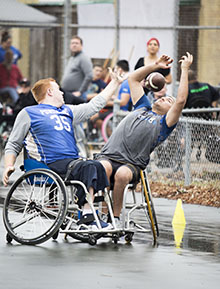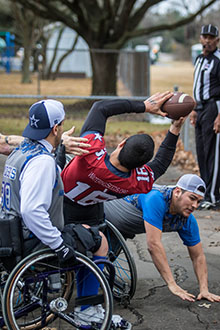The history, the rules and how the Wheelchair Super Bowl got started.
Although wheelchair football has been around since 1996, it isn’t something you see every day. The American Association of Adapted Sports Programs, Inc. started it over 20 years ago to give adaptive athletes the chance to compete in one of the most popular sports in America.

Wheelchair football uses a standard-sized foam football and all players must use a wheelchair, even if they are ambulatory. Both manual and motorized wheelchairs can be used to play. The game is played indoors on basketball courts or outdoors on gravel courts. The standard field size is 60 x 25 yards that is divided into 15-yard segments with the end zones measuring at eight yards. Wheelchair football is coed, giving the opportunity to both male and female athletes. The game calls for seven players from each team to be on the field at once, and is played in two 20 minute halves with a quick five-minute half time.
The rules are similar to those of touch football where players must touch their opponents rather than tackle them. In this case, players must touch their opponent from the waste up. Touching the person’s legs or their wheelchair will not count as a tackle.

Like most adaptive sports, players are classified into different levels and the rules are slightly different for each level. In wheelchair football, there are three levels:
- Level 1: players who have full use of their arms, hands and eyes
- Level 2: Players who have limited arm and/or hand movement and/or some type of visual impairment
- Level 3: Players who have no arm movement capability and/or have limited sight
Over 70 athletes recently got the chance to compete in the Watering Seeds Organization (WSO) Wheelchair Super Bowl II that was held January 27 and 28 in Pasadena, Texas. WSO founder, Brady Mazzola, and WSO Sports and Tournament Director, Erik Mendez, thought of the idea for a wheelchair super bowl in the summer of 2016 when they noticed a high demand for the sport.
“This all-inclusive football tournament is designed to bridge the gap between the able-bodied and disabled communities by bringing them together to compete in a fun, healthy and safe environment,” says Mazzola. “These community driven, adaptive sporting events are instrumental in the healing, rehabilitation and wellness of wounded veterans and challenged civilians.”
Mazzola hopes to expand their outreach and to continuously grow this event from a regional to a nationally branded tournament with more athletes, sponsors and to grow the fan-base for the sport.